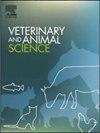A nuclear magnetic resonance spectroscopy metabolomic approach to renal dysfunction in canine leishmaniasis
IF 1.9
Q2 AGRICULTURE, DAIRY & ANIMAL SCIENCE
引用次数: 0
Abstract
Chronic kidney disease (CKD) is a major complication and the leading cause of mortality in canine leishmaniasis (CanL). The kidneys are essential for numerous metabolic processes, and specific metabolites may serve as predictive biomarkers of kidney function. Nuclear Magnetic Resonance (NMR) spectroscopy is a prominent analytical tool in metabolomics, capable of identifying metabolites in urine. This study aim to identify distinct patterns in the NMR spectra of urine samples from dogs with CKD in CanL, reflecting the underlying metabolic profiles
Fifty-five dogs were divided into three groups: 14 healthy control dogs (CG), 33 dogs with CKD secondary to leishmaniasis, and 8 dogs with CKD unrelated to leishmaniasis. CanL dogs were classified according to the International Renal Interest Society (IRIS) staging system: stage 1 (15 dogs), stage 2 (10 dogs), stage 3 (6 dogs), and stage 4 (2 dogs); and by LeishVet guidelines: stage I (5 dogs), stage II (4 dogs), stage III (14 dogs), and stage IV (10 dogs). Among dogs with CKD alone, one dog was in IRIS stage 1, two in stage 2, one in stage 3, and four in stage 4.
Low-field proton nuclear magnetic resonance (1H NMR) spectroscopy and multivariate analysis were used to classify urine samples. Statistical analysis was conducted on hematology, urine and plasma samples from studied dogs.
Using 1H NMR spectroscopy to classify urine samples from dogs with CKD, both with and without leishmaniasis, revealed distinct spectral patterns between the different groups.
In conclusion, low-field 1H NMR spectroscopy demonstrated that CKD presents a distinct metabolic profile compared to kidney damage secondary to leishmaniasis.
犬利什曼病肾功能障碍的核磁共振谱代谢组学研究
慢性肾脏疾病(CKD)是犬利什曼病(CanL)的主要并发症和主要死亡原因。肾脏对许多代谢过程至关重要,特定的代谢物可以作为肾脏功能的预测性生物标志物。核磁共振(NMR)光谱是代谢组学中重要的分析工具,能够识别尿液中的代谢物。研究人员将55只狗分为三组:14只健康对照狗(CG)、33只继发于利什曼病的CKD狗和8只与利什曼病无关的CKD狗。CanL犬按照国际肾利益协会(IRIS)分期系统进行分类:1期(15只)、2期(10只)、3期(6只)、4期(2只);根据LeishVet的指导方针:第一阶段(5只狗),第二阶段(4只狗),第三阶段(14只狗),第四阶段(10只狗)。在单独患有CKD的狗中,1只狗处于IRIS 1期,2只处于2期,1只处于3期,4只处于4期。采用低场质子核磁共振(1H NMR)波谱和多变量分析对尿样进行分类。对研究犬的血液学、尿液和血浆样本进行统计分析。使用1H NMR光谱对患有和不患有利什曼病的CKD狗的尿液样本进行分类,揭示了不同组之间不同的光谱模式。总之,低场1H NMR谱显示,与利什曼病继发肾损伤相比,CKD具有不同的代谢谱。
本文章由计算机程序翻译,如有差异,请以英文原文为准。
求助全文
约1分钟内获得全文
求助全文
来源期刊

Veterinary and Animal Science
Veterinary-Veterinary (all)
CiteScore
3.50
自引率
0.00%
发文量
43
审稿时长
47 days
 求助内容:
求助内容: 应助结果提醒方式:
应助结果提醒方式:


